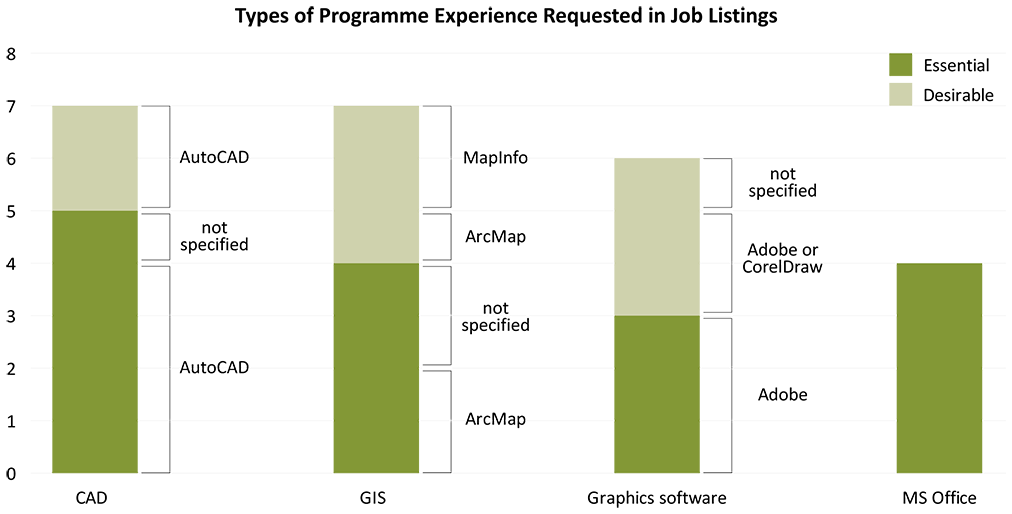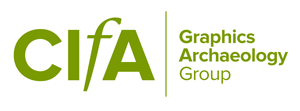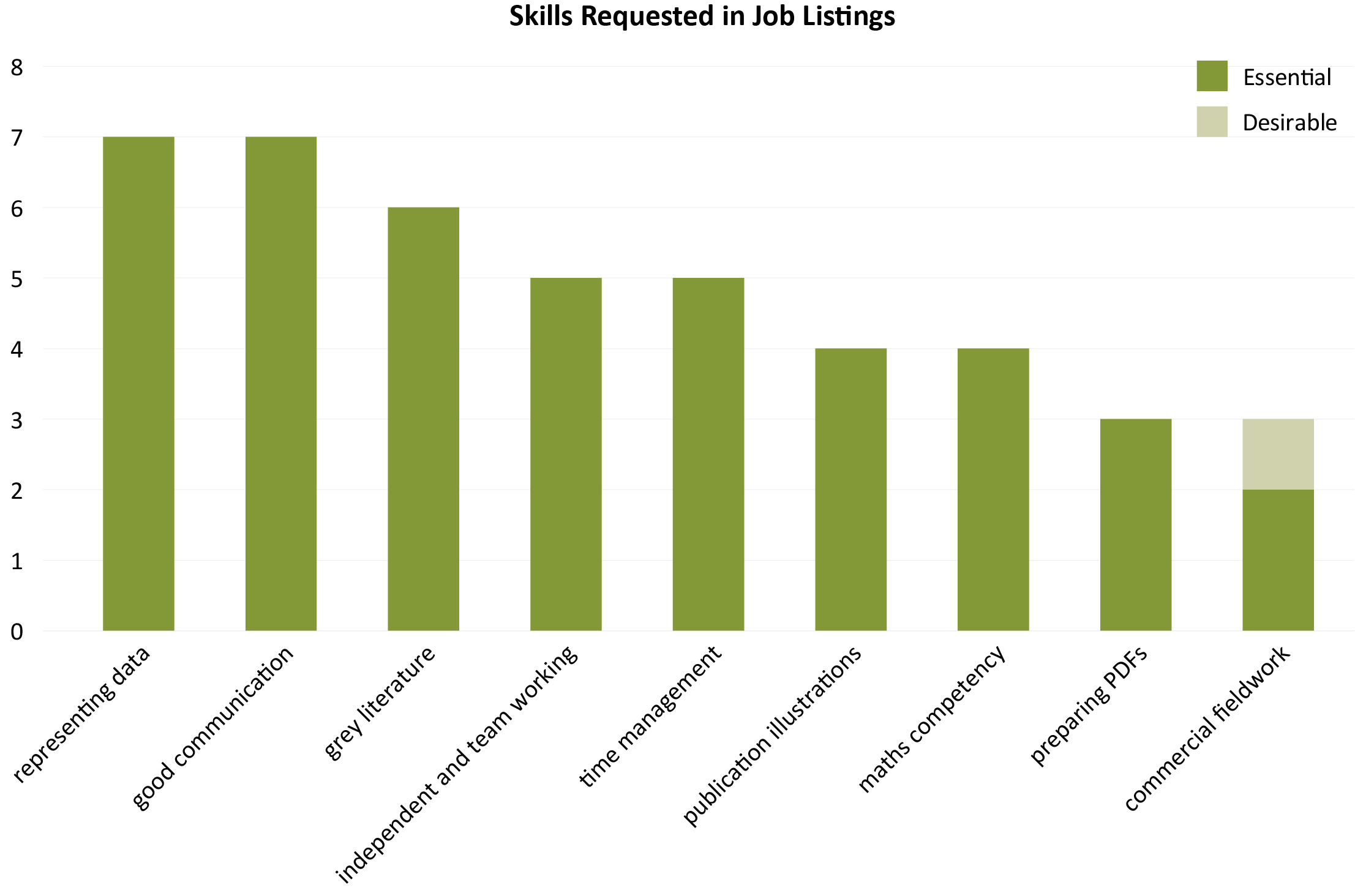The following is informed by research, but it includes a personal perspective from somebody working as an archaeological illustrator in a commercial unit. Some may have a different perspective, but I will try to guide you through my experiences and findings. Good luck.
Review of Archaeological Illustration Job Adverts 2018–2019
These statistics were put together following a review of job adverts found on CIfA’s JIST and BAJR’s job listings. This includes 10 job adverts over the space of about 12 months. Over this period, I saw only one advert that was open to junior applicants, and none that were for senior illustrators or graphics managers. These statistics are specific to graphic designer and illustrator roles, so unfortunately surveyor roles have been excluded. Do see our page Getting Started in Survey for information specific to surveying.
The job listings regularly mentioned whether something was “essential” or “desirable”; however, some did not specify. Many asked for experience in specific types of software, detailed below:
Software

GIS
• 7/10 asked for experience in GIS
• 4 said this was essential, 3 said it was desirable
• Of these, 3 asked for ArcMap, 2 asked for MapInfo, and 2 did not specify
Anecdotally, QGIS is also regularly mentioned in job adverts.
CAD
• 7/10 asked for experience in CAD
• 5 said this was essential, 2 said it was desirable
• Of these, 6 asked for AutoCAD and 1 did not specify
Again, anecdotally, DraftSight is also used in the industry, though this may change following its change to a paid-for system. Some units will try to do as much as possible in GIS instead in order to reduce the amount of staff members using CAD.
Graphics Software
• 6/10 asked for experience in graphics software
• 3 said this was essential, 3 said it was desirable
• Of these, 4 asked for Adobe Suite, 2 asked for Adobe Suite OR CorelDraw
The relatively low number here is surprising, given that this sort of software is likely to be used by all illustrators, and perhaps it was assumed by the advert-writers that it was a given. On the whole, the Adobe programmes illustrators will use are Illustrator, Acrobat, Photoshop and InDesign, in rough order of how frequently they are likely to be used.
Other Software
• 4/10 asked for experience in MS Office
• All of these said this was essential
Top Skills
Here are the top 9 skills that were asked for specifically in the job listings:
Representing Archaeological Data
• 7/10 asked for this skill
• All 7 said this was essential
Interestingly, this is essentially just a description of the role of an illustrator. I can only assume that the remaining 3 job listings were written with this as an assumption, or else are open to junior illustrators.
Fluent or good English/good communication skills
• 7/10 asked for this skill
• All 7 said this was essential
Experience with grey literature
• 6/10 asked for this skill
• All 6 said this was essential
For the uninitiated, grey literature tends to be site reports that are supplied to clients but not published as such. Therefore, this represents an expectation that illustrators have prepared illustrations for these kinds of reports before.
Ability to work independently and part of a team
• 5/10 asked for this skill
• All 5 said this was essential
Organisation and time management skills
• 5/10 asked for this skill
• All 5 said this was essential
Experience preparing illustrations for publication
• 4/10 asked for this skill
• All 4 said this was essential
Publications is as opposed to grey literature. These are illustrations likely to be in journals or books published by a unit.
Maths competency
• 4/10 asked for this skill
• All 4 said this was essential
Preparing PDFs
• 3/10 asked for this skill
• All 3 said this was essential
Commercial fieldwork experience
• 3/10 asked for this skill
• 2 said this skill was essential
• 1 said this was desirable
This came as a surprise to me, as I started to apply to illustrator roles before I had commercial experience, and found that it was a major stumbling block in my applications. There seems to be some openness to accepting academic dig experience, but no excavation experience will not serve you well, and commercial experience is particularly encouraged.
Other skills and experience include CIfA membership, experience with guidance/training of other staff, experience in other heritage sector graphics, adherence to CIfA standards, hand-drawn illustration, degree in archaeology or equivalent, editing templates within software, and video capture/editing.
Specialist Skills

2 job adverts asked for a specialism without specifying which specialism they were looking for. Specialisms asked for included:
Finds illustration
2; 1 essential, 1 desirable
Photography
2; 1 essential, 1 desirable
Survey
2; 1 essential, 1 desirable
Reconstruction
2 desirable
3D modelling
2 desirable
Photogrammetry
1 desirable
Salary
Bear in mind that these data were collected in 2018 and 2019. The average minimum salary was £22,160 and the average maximum salary was £25,920. The lowest minimum was £18,900 and the highest maximum was £28,477. These salaries are highly dependent on location. All jobs gave a salary range dependent on experience and while one ad was open to junior illustrators, none mentioned senior illustrators or graphics managers. We therefore have no data for these kinds of positions, but if you do, please get in touch.
Based on data collected in 2017–2018 across the sector, these salary ranges are comparable to being between Supervisor and Officer roles in archaeology. In 2017–2018, the lowest Illustrator salary found was £18,000, the average was £23,748 and the highest was £27,250. This compares to surveyor salaries, the lowest of which was £18,000, the average was £24,999, and the highest was £40,000. (Lewis B, Rocks-Macqueen D & Young Ann S, 2019, The Archaeologist Issue 108).
Recommendations for Getting Started
Get Digging
From experience, having done excavation is practically essential even though this is not necessarily mentioned in the job listings. Some stated commercial archaeology experience, but many would be likely to accept experience digging while on a university degree or as a volunteer. If you do not have this experience, try to get it by volunteering at a local unit or looking out for volunteering opportunities in community archaeology or abroad. Some units offer training schemes as well. Not only is this something units ask for, it WILL make you a better illustrator. I didn’t realise how uninformed I was until I started digging. Graphic design experience is not enough.
Prepare a Portfolio
Have a portfolio of graphic work, including plenty of archaeological work, at the ready. This should include maps, plans, sections, finds, plus any specialism you have such as photography or reconstruction. Some units may require other sorts of graphic work, such as for web or promotion. Look on their website to see what sort of material they put out to tailor your portfolio. If you have not worked in commercial archaeology before, look at grey literature reports put out by units to see what is often required and see if you can find a way to produce graphics like them. For publications, have a look at any online journals to see the sorts of graphics they publish, and you can even look at their submission guidelines for the things they request for submissions. You can create maps for free by using QGIS and downloading free OS data. If you are likely to use hachures (a convention that signifies the top and bottom of a slope in landscape/earthwork survey), click here to download some Adobe Illustrator brushes provided by Historic England. If you have never drawn any finds, see if you can get access to things like pieces of pottery to draw and practice drawing things to scale. You may have to volunteer at a unit or museum to do this. Don’t forget to look at our Resources page for more pointers.
Learn the Software
If you learn on Open Source alternatives, this will put you in much better stead than having never touched the software at all. If you are a student, you may have access to software or be eligible for discounted software. Have a look on our Resources page for software and tutorials.
ArcMap (ArcGIS) and AutoCAD are the most commonly cited GIS and CAD programmes, but both are expensive. Try using a free trial of these programmes once you have learned how to use the free or cheaper alternatives; DraftSight is a cheap (used to be free) CAD programme, and QGIS is a free Open Source GIS programme. Some units use these programmes anyway.
The Adobe Suite is the industry standard graphic software and you can pay for a short subscription to the Creative Cloud service to get used to the software. CorelDraw is also used in the industry and is available as a subscription or to buy outright, although it is still not cheap. OpenSource alternatives include GIMP for raster files and InkScape for vector files, which should help you to understand the things graphics editing software can do, but do your research as some other alternatives may be more intuitive or similar to Adobe.
Become familiar with CIfA
Although some places don’t require membership, familiarising yourself or joining could help you via interaction with the special interest groups, the CIfA Conference, and guidance on the CIfA website. Get an idea of the industry standards by reading the regulations, standards and guidelines documents.
Keep a Look Out
Frequent the BAJR jobs page, and if you are a CIfA member look at their JIST emails. Also look at the jobs pages of archaeology units. You can find a list of CIfA-registered units on the CIfA website and you can set up alerts for when their jobs pages are updated; one service that does this is Visualping.
And…
Be computer literate, have an understanding of archaeology as a discipline and an industry, and if possible be willing to move for your work. These posts are not advertised very regularly so your dream job could be in a different part of the country. Remote working is quite unusual and freelance work is tough for people who don’t already have the experience. You will probably want to start your career in a unit where you can learn from the other illustrators and receive formal training in the areas you do not already have experience in.
Going freelance
For advice on going freelance as a graphics professional, see our page Getting Started as a Freelance Illustrator.
We would, however, advise freelancing only for those who are already very experienced.
We do hope this will be helpful for early career illustrators. Let the GAG committee know if you have any further or specific questions or suggestions by emailing us at contact@gag-cifa.org.
If you run or know of a course teaching archaeological illustration techniques, please also email us to have it listed here and on our Resources page.

